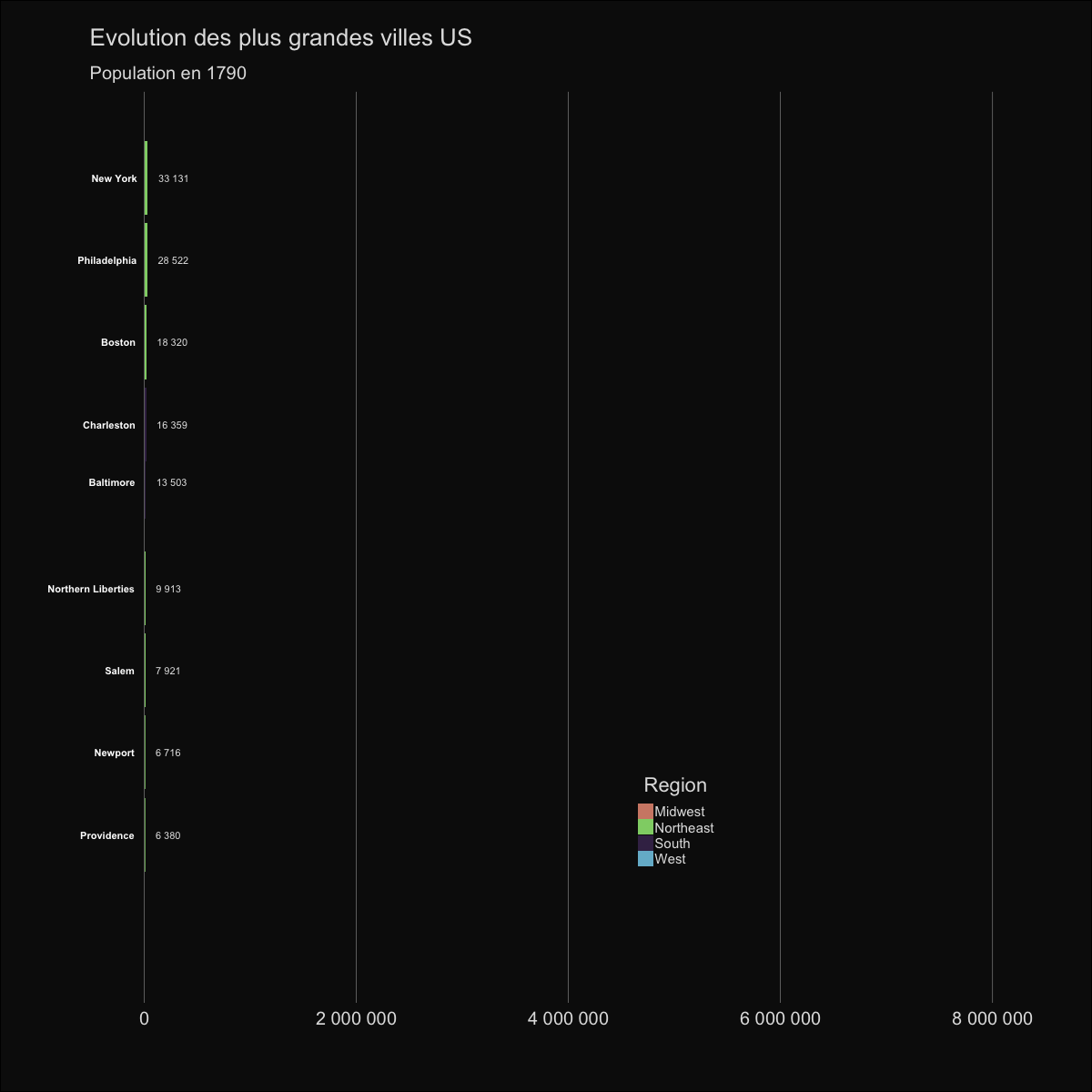## TODO #### 1. charger le dataset `us_city_populations` de la librairie `vizoR` #### 2. tracer un line chart de l'évolution de la population des villes US #### 3. Mettez en évidence les 5 plus grandes villes (hint: package gghighlight) [introduction gghighlight](https://cran.r-project.org/web/packages/gghighlight/vignettes/gghighlight.html) #### 4. Appliquez les principes de design de Tufte ##### 5. BONUS: affichez le nom des villes directement à la fin de la ligne #### 6. Réalisez un streamgraph des 5 plus grandes villes US (hint: package ggTimeSeries) --- ## TODO 2 #### Trouver une 3e visualization pertinente pour montrer l'évolution de la population des villes US. --- ```r data("us_city_populations") n_cities = 5 last_ranks <- us_city_populations %>% filter(Year == max(Year)) %>% mutate(last_rank = Rank) %>% select(City, last_rank) to_plot <- left_join(us_city_populations, last_ranks, by= 'City') right_axis <- to_plot %>% group_by(City) %>% top_n(1, Year) %>% ungroup() %>% top_n(n_cities, -last_rank) ends <- right_axis %>% pull(Population) labels <- right_axis %>% pull(City) ``` --- class: full ```r p <- ggplot(to_plot, aes(x=Year, y = Population, group = City, color = City)) + geom_line(size=1) + scale_x_continuous("", expand=c(0,0))+ scale_y_continuous("", labels=scales::comma_format(big.mark = " "), sec.axis = sec_axis(~ ., breaks = ends, labels = labels ))+ scale_color_viridis_d()+ theme_elegant_dark()+ theme(legend.position = "none", plot.margin = unit(c(1,3,1,1), "lines"), axis.line.y = element_blank(), axis.line.x = element_blank(), axis.ticks.x = element_line(), panel.grid.major.y = element_line(color= 'grey30', size = .2) ) + gghighlight(max(last_rank) <= n_cities, use_direct_label = FALSE, label_key = City, unhighlighted_colour = "grey20") ``` --- class: full ```r p ``` <!-- --> --- class: full ```r library(ggTimeSeries) p <- to_plot %>% filter(City %in% labels) %>% ggplot(aes(x = Year, y = Population, group = City, fill = City)) + scale_y_continuous("", labels = scales::comma_format(big.mark = " "))+ stat_steamgraph() + theme_elegant_dark() + scale_fill_viridis_d() + theme(plot.margin = unit(c(1,3,1,1), "lines"), axis.line.y = element_blank(), axis.line.x = element_blank(), axis.ticks.x = element_line(), panel.grid.major.y = element_line(color= 'grey30', size = .2) ) ``` --- class: full ```r p ``` <!-- --> --- class: inverse, center, middle # Barchart race --- ## Load data ```r data("us_city_populations") n_cities = 10 top_cities <-us_city_populations %>% filter(Rank <= n_cities) %>% select(City, State, Region) %>% distinct() ``` --- ## Create all missing dates ```r # create a data frame with all the years between min and max Year all_years <- data.frame(Year = seq(min(us_city_populations$Year), max(us_city_populations$Year), 1)) # combine top_cities and all_years all_combos <- merge(top_cities, all_years, all = T) # combine all_combos with the original dataset res_interp <- merge(us_city_populations, all_combos, all.y = T) ``` ## Interpolate the Populations when missing (linear interpolation here) ```r res_interp <- res_interp %>% group_by(City) %>% mutate(Population=approx(Year,Population,Year)$y) ``` --- ## Filter data ```r to_plot <- res_interp %>% group_by(Year) %>% arrange(-Population) %>% mutate(Rank=row_number()) %>% filter(Rank<=n_cities) ``` --- ## Ease transitions ```r to_plot_trans <- to_plot %>% group_by(City) %>% arrange(Year) %>% mutate(lag_rank = lag(Rank, 1), change = ifelse(Rank > lag(Rank, 1), 1, 0), change = ifelse(Rank < lag(Rank, 1), -1, 0)) %>% mutate(transition = ifelse(lead(change, 1) == -1, -.9, 0), transition = ifelse(lead(change,2) == -1, -.5, transition), transition = ifelse(lead(change,3) == -1, -.3, transition), transition = ifelse(lead(change, 1) == 1, .9, transition), transition = ifelse(lead(change,2) == 1, .5, transition), transition = ifelse(lead(change,3) == 1, .3, transition)) %>% mutate(trans_rank = Rank + transition) ``` --- ## Make the plot .small[ ```r p <- to_plot_trans %>% ggplot(aes(x = -trans_rank,y = Population, group =City)) + geom_tile(aes(y = Population / 2, height = Population, fill = Region), width = 0.9) + geom_text(aes(label = City), hjust = "right", colour = "white", fontface="bold", nudge_y = -100000) + geom_text(aes(label = scales::comma(Population,big.mark = ' ')), hjust = "left", nudge_y = 100000, colour = "grey90") + coord_flip(clip="off") + hrbrthemes::scale_fill_ipsum() + scale_x_discrete("") + scale_y_continuous("",labels=scales::comma_format(big.mark = " ")) + theme_elegant_dark(base_size = 20) + theme( panel.grid.minor.x=element_blank(), axis.line = element_blank(), panel.grid.major= element_line(color='lightgrey', size=.2), legend.position = c(0.6, 0.2), plot.margin = margin(1,1,1,2,"cm"), plot.title = element_text(hjust = 0), axis.text.y=element_blank(), legend.text = element_text(size = 15), legend.background = element_blank()) + # gganimate code to transition by year: transition_time(Year) + ease_aes('cubic-in-out') + labs(title='Evolution des plus grandes villes US', subtitle='Population en {round(frame_time,0)}') ``` ] --- ```r animate(p, nframes = 400, fps = 25, end_pause = 30, width = 1200) anim_save("bar_race.gif", animation = last_animation()) ``` 